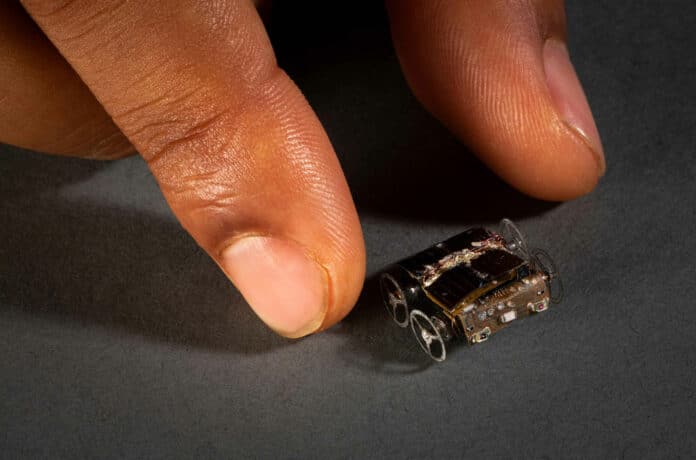Small mobile robots equipped with sensors have the potential to perform a range of tasks, from detecting gas leaks to tracking inventory in warehouses. However, the movement of these robots requires a significant amount of energy, and batteries, which are typically used as a power source, have limitations that can impact their lifetime and raise environmental concerns.
Now, researchers at the University of Washington have created MilliMobile, a tiny, battery-free autonomous robot capable of operating on harvested energy from ambient light and radio waves.
The tiny, self-driving robot features a solar panel-like energy harvester and four wheels, measures just 10 mm (0.4 in) per side, and weighs less than 1.1 g. The robot can reportedly travel a distance of 30 feet (9 meters) in an hour, even on cloudy days.
MilliMobile can move on surfaces like concrete and packed soil and can carry equipment that payloads nearly three times its own weight, such as a camera or sensors. It uses a light sensor to autonomously steer itself towards a specified light source and can operate indefinitely on harvested power.
“We took inspiration from ‘intermittent computing,’ which breaks complex programs into small steps, so a device with very limited power can work incrementally, as energy is available,” said co-lead author Kyle Johnson. “With MilliMobile, we applied this concept to motion. We reduced the robot’s size and weight, so it takes only a small amount of energy to move. And, similar to an animal taking steps, our robot moves in discrete increments, using small pulses of energy to turn its wheels.”
The team tested MilliMobile, both indoor and outdoor, in environments such as parks, an indoor hydroponic farm, and an office. Even in very low light situations, the robots are still able to inch along, though much slower. With the ability to run continuously, these robots could prove to be a valuable asset in areas where traditional sensors fail to provide accurate data.
Moreover, the batteryless robots have the capability to navigate themselves using their onboard sensors and tiny computing chips. To demonstrate this, the team programmed the robots to detect a light source using their light sensors and move toward it.
Researchers have outfitted MilliMobile with sensors that can detect light, temperature, and humidity, alongside Bluetooth capabilities that allow it to send data over distances of up to 650 feet (200 meters). In the future, researchers plan to expand its functionality by including other types of sensors and enhancing the robots’ ability to share data between themselves in swarms.
The ability to carry a wide variety of sensor payloads enables numerous application scenarios. MilliMobile could seek out gas or chemical leaks using gas sensors, metal objects with a magnetometer, RF sources using an antenna and receiver or envelope detector, temperature for detecting fires or sources of heat, and much more.
